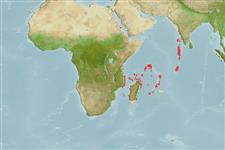التصنيف / Names
الأسماء الشائعة | مرادفات | Catalog of Fishes(جنس, الانواع) | ITIS | CoL | WoRMS | Cloffa
>
Blenniiformes (Blennies) >
Tripterygiidae (Triplefin blennies) > Tripterygiinae
Etymology: Enneapterygius: Greek, ennea = nine times + Greek, pterygion = little fin (Ref. 45335); gruschkai: Named for Victor Gruschka Springer, doyen of blennioid systematics (Ref. 57774).
Eponymy: Dr Victor Gruschka Springer (d: 1928) is a marine biologist and zoologist who is Senior Scientist emeritus, Division of Fishes at the Smithsonian, NMNH. [...] (Ref. 128868), visit book page.
Environment: milieu / climate zone / depth range / distribution range
البيئة
بحري القاع; نطاق العمق 1 - 8 m (Ref. 57774). Tropical
Western Indian Ocean: appears to be restricted to the islands of the western and central Indian Ocean.
الحجم / وزن / العمر
Maturity: Lm ? range ? - ? cm
Max length : 2.9 cm SL ذكر/ مختلط الجنس; (Ref. 57774)
وصف مختصر
مفاتيح التعريف | الوصف الخارجي | قياسات المظهر الخارجي
الأشواك الظهرية (المجموع) : 15 - 16; الأشعة الظهرية الناعمة (المجموع) : 8 - 11; شوكة شرجية: 1; أشعه شرجية لينه: 17 - 19. Dorsal fin III+XII-XIII+8-11 (usually III+XIII+9-10); anal fin I,17-19 (usually 18-19 rays); pectoral fins 15: 2+7+6 (occasionally 3+6+6); lateral line with 14-16 (usually 15) pored scales and 19-23 (usually 20-21) notched scales, notched segment starting next scale row below end of pored segment, below mid-second dorsal fin. Total lateral scales 33; transverse scales 3/5. Vertebrae 10+25. Mandibular pores 3+2+3. Head length 3.1-3.6, body depth 5.4-5.9 in SL;
eye 2.7-3.2 in head length. A medium-sized species of Enneapterygius (less than 30 mm SL). Nape scaled, body scales continuing to bases of dorsal and anal fins; belly naked. Pelvic-fin rays not united by membrane. First dorsal fin equal in height to second, second about 70% of body depth. Simple, lobate orbital and anterior nasal cirri present. Supratemporal sensory canal slightly curved. Tongue triangular and sharply pointed; maxilla reaches vertical through
anterior margin of pupil; broad band of teeth in upper and front of lower jaw; palatines without teeth. Spines of first dorsal fin with small, laterally projecting spinelets (Ref. 57774).
Female members of the Tripterygiidae have eggs that are hemispherical and covered with numerous sticky threads that anchor them in the algae on the nesting sites (Ref. 240). Larvae are planktonic which occur primarily in shallow, nearshore waters (Ref. 94114).
Life cycle and mating behavior
النضج | التكاثر | وضع البيض | بيض | الخصوبة | Larvae
Holleman, W., 2005. A review of the triplefin fish genus Enneapterygius (Blennioidei: Tripterygidae) in the western Indian Ocean, with descriptions of four new species. Smithiana, Bull. 5:1-25. (Ref. 57774)
IUCN Red List Status (Ref. 130435: Version 2024-2)
استخدامات بشرية
مصائد: غير ذات اهمية
أدوات
تقارير خاصة
Download XML
مصادر علي الأنترنت
Estimates based on models
Preferred temperature (Ref.
123201): 25.5 - 29, mean 27.5 °C (based on 120 cells).
Phylogenetic diversity index (Ref.
82804): PD
50 = 0.5000 [Uniqueness, from 0.5 = low to 2.0 = high].
Bayesian length-weight: a=0.00617 (0.00288 - 0.01322), b=3.04 (2.86 - 3.22), in cm total length, based on LWR estimates for this (Sub)family-body shape (Ref.
93245).
مستوى غذائي (Ref.
69278): 3.1 ±0.3 se; based on size and trophs of closest relatives
المرونه (Ref.
120179): عالي, الحد الزمني الأدني لتضاعف عدد أفراد المجتمع أقل من 15 شهر (Preliminary K or Fecundity.).
Fishing Vulnerability (Ref.
59153): Low vulnerability (10 of 100).
